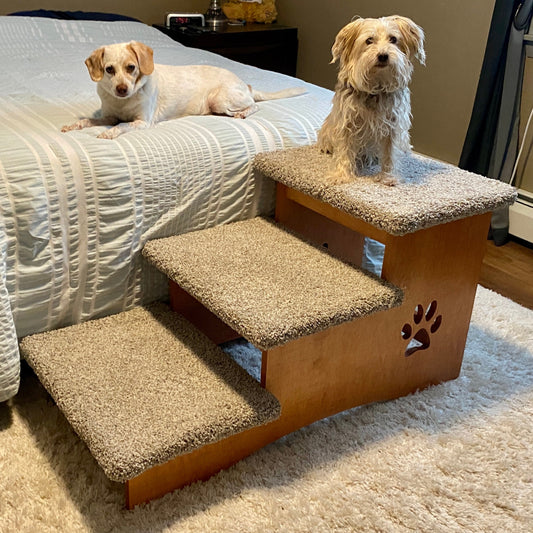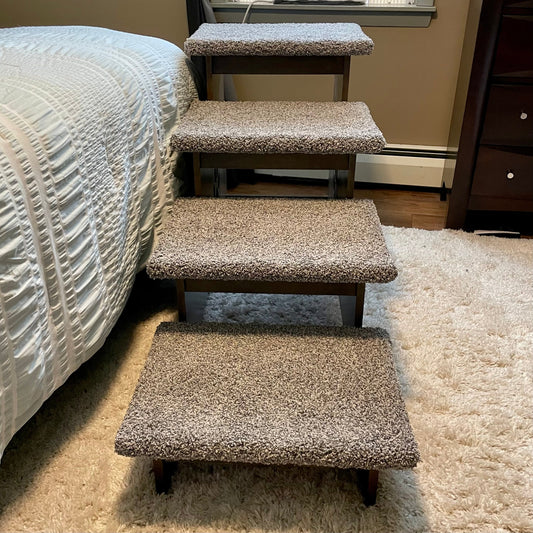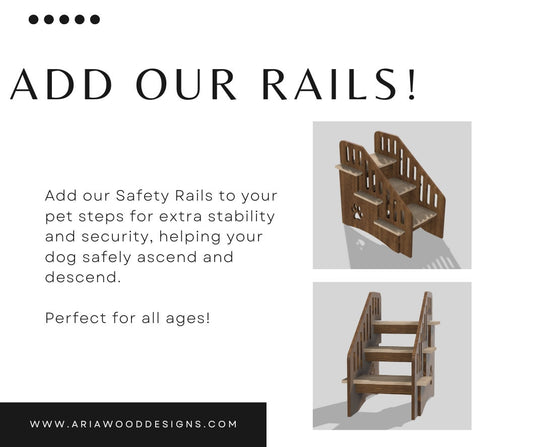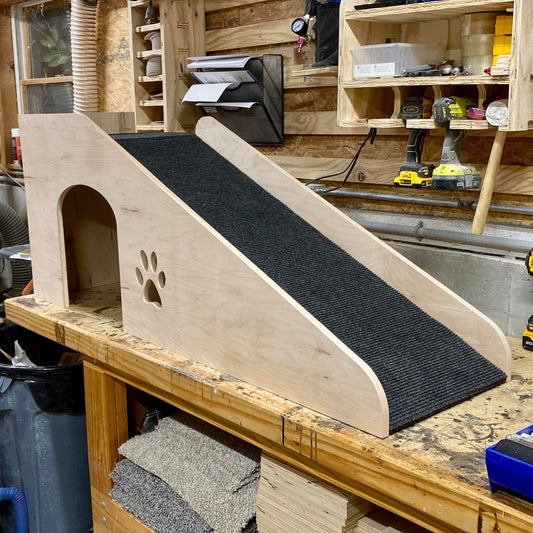Your furry friend has always been your faithful companion, following you everywhere from the couch to the bedroom. But lately, you've noticed something concerning—your once-agile pup hesitates before jumping onto your bed, or worse, they've stopped trying altogether. This scenario plays out in countless homes across America, leaving pet parents searching for solutions that protect their dog's joints while maintaining their independence.
Pet stairs offer an elegant solution to this common challenge. These specially designed steps provide dogs of all ages and sizes with a safe, comfortable way to access elevated surfaces without the strain of jumping. From puppies learning to navigate furniture to senior dogs with arthritis, pet stairs can transform your home into a more accessible environment for your four-legged family member.
This comprehensive guide will walk you through everything you need to know about pet stairs, from understanding when your dog needs them to selecting the perfect size and style for your home. By the end, you'll have the knowledge to make an informed decision that prioritizes your pet's health, safety, and happiness.

When Your Dog Needs Pet Stairs
Dogs are naturally athletic creatures, but various factors can make jumping challenging or even dangerous. Recognizing the signs that your dog could benefit from dog steps is the first step toward protecting their long-term health.
Age-Related Changes
Senior dogs often experience joint stiffness, arthritis, and reduced mobility which makes jumping painful or impossible. However, age isn't the only factor to consider. Some dogs develop joint issues as early as middle age, particularly larger breeds prone to hip dysplasia or elbow problems.
Watch for subtle signs like hesitation before jumping, stiff movements after resting, or reluctance to access previously favorite spots. These behaviors often confirm discomfort that pet stairs can alleviate.
Size Considerations
Small and toy breeds face unique challenges when navigating furniture designed for humans. A Chihuahua attempting to reach a standard bed essentially faces the equivalent of a person jumping onto a platform several feet high. This disproportionate height difference puts enormous stress on tiny joints and can lead to injuries.
Large dogs present different concerns. While they may easily reach elevated surfaces, the impact from jumping down can be devastating to their joints over time. Heavy breeds like Great Danes, German Shepherds, and Golden Retrievers benefit significantly from stairs that provide controlled, gradual descent.
Post-Surgery Recovery
Dogs recovering from orthopedic surgery, ACL repairs, or other procedures often require strict activity restrictions. Pet stairs allow these recovering pets to maintain some independence while protecting healing tissues from the impact of jumping.
Dog Stairs vs. Dog Ramps: Understanding Your Options
When shopping for mobility aids, you'll encounter two main categories: stairs and ramps. Each option offers distinct advantages depending on your dog's specific needs and preferences.
Pet Stairs: Step-by-Step Solution
Dog stairs feature individual steps that create a stair-like ascending path. These work well for dogs comfortable with the stepping motion and provide stable platforms for each paw placement. The discrete steps make them feel more natural for many dogs who instinctively understand the climbing motion.
Most pet stairs come in various heights, typically ranging from 14 to 30 inches, accommodating everything from low couches to high beds. The step depth varies as well, with deeper steps better suited for larger dogs who need more space to place their paws securely.
Dog Ramps: Gentle Incline Approach
Dog ramps provide a gradual incline without individual steps. This design particularly benefits dogs with severe mobility issues, those recovering from surgery, or pets who struggle with the stepping motion. The continuous surface allows dogs to walk naturally up and down without lifting their legs high.
Ramps typically require more floor space than stairs due to their length, but they offer the gentlest possible ascent and descent. They're often the preferred choice for dogs with neurological conditions or severe arthritis.
Making the Right Choice
Consider your dog's personality and physical capabilities when choosing between stairs and ramps. Some dogs prefer the defined steps of stairs, while others find ramps less intimidating. If your dog already uses outdoor steps comfortably, they'll likely adapt quickly to pet stairs. Dogs who struggle with coordination or balance may find ramps easier to navigate.
Choosing the Perfect Size and Height
Selecting the right size pet stairs requires careful measurement and consideration of your dog's physical characteristics. The goal is creating a comfortable, safe pathway that reduces strain while feeling natural to use.
Measuring Your Space
Start by measuring the height from the floor to the surface your dog wants to access. Standard bed heights typically range from 18 to 30 inches, while couches usually measure 14 to 20 inches high. Add a few inches to account for mattress thickness or cushion depth.
Next, measure the available floor space. Pet stairs extend outward from furniture, so ensure adequate room for both the stairs and your dog's approach. Consider traffic flow in the room—you don't want stairs creating obstacles for human family members.
Step Dimensions Matter
Step depth plays a crucial role in safety and comfort. Small dogs (under 25 pounds) can navigate steps 8 to 10 inches deep, while medium dogs (25-60 pounds) benefit from 10 to 12-inch depths. Large dogs (over 60 pounds) need steps at least 12 to 14 inches deep for secure paw placement.
Step height should allow comfortable movement without excessive lifting. Most dogs handle 6 to 8-inch step heights well, though smaller dogs may prefer 4 to 6 inches. Very large dogs can typically manage slightly higher steps.
Width Considerations
Stair width should accommodate your dog's natural gait. Small dogs need at least 12 inches of width, while large breeds require 16 to 20 inches or more. Wider stairs provide extra stability and confidence, particularly for dogs still learning to use them.
Materials and Construction: What Makes Quality Pet Stairs
The construction quality of pet stairs directly impacts their safety, durability, and longevity. Understanding different materials and construction methods helps you identify products that will serve your dog well for years to come.
Wood Construction Benefits
High-quality wooden pet stairs offer superior stability and durability compared to plastic alternatives. Solid wood construction provides the weight necessary to prevent sliding or tipping, creating confidence for dogs who might be hesitant about new equipment.
Look for stairs made from hardwood plywood or solid wood rather than particle board or MDF. These materials resist warping and maintain structural integrity over time. Quality manufacturers use techniques like pocket-hole joinery, which creates exceptionally strong connections between pieces.
Surface Materials
The stair surface requires careful consideration for both safety and comfort. Carpeted surfaces provide traction and cushioning but require more maintenance. Choose pet-friendly carpeting that resists stains and odors while providing adequate grip.
Some stairs feature removable, washable carpet sections that maintain hygiene while providing traction. Others incorporate textured surfaces or grip strips for dogs who prefer non-carpeted options.
Weight Capacity and Stability
Always verify that stairs can safely support your dog's weight with a significant safety margin. Quality pet stairs typically support 150 to 200 pounds or more, even for models designed for smaller dogs. This extra capacity ensures stability and prevents flexing during use.
The base design affects stability significantly. Look for stairs with wide, stable bases that resist tipping. Some models include non-slip pads on the bottom to prevent sliding on smooth floors.
Training Your Dog to Use Pet Stairs
Even the best pet stairs won't help if your dog refuses to use them. Successful stair introduction requires patience, positive reinforcement, and gradual conditioning to build confidence and create positive associations.
Introduction Phase
Start by placing the stairs near your dog's favorite spot without forcing interaction. Allow natural curiosity to develop by letting your dog investigate at their own pace. Reward any interest or interaction with treats and praise.
Place treats on individual steps to encourage exploration. Begin with treats on the bottom step and gradually work upward as your dog becomes comfortable. Never force or drag your dog onto the stairs, as this creates negative associations that can be difficult to overcome.
Building Confidence
Some dogs take to stairs immediately, while others need time to build confidence. Begin training sessions when your dog is calm but motivated—perhaps before meal times when they're hungry for treats.
Use high-value rewards and enthusiastic praise for any interaction with the stairs. Start by rewarding your dog for simply approaching the stairs, then for placing one paw on the bottom step, and gradually for climbing higher.
Addressing Hesitation
If your dog shows fear or reluctance, slow the process considerably. Some dogs benefit from having the stairs positioned away from furniture initially, allowing them to practice climbing without the pressure of reaching a destination.
For particularly anxious dogs, consider starting with just one or two steps, adding height gradually as confidence builds. The goal is creating positive experiences that make your dog eager to use their new stairs.
Maintenance and Care for Longevity
Proper maintenance extends the life of pet stairs while ensuring ongoing safety for your furry friend. Regular care prevents wear-related problems and maintains the stairs' appearance in your home.
Regular Cleaning
Carpeted stairs require vacuuming to remove pet hair, dirt, and debris that can create odors or reduce traction. For washable carpet options, follow manufacturer guidelines for cleaning frequency and methods.
Wooden surfaces need periodic dusting and occasional treatment with appropriate wood care products. Avoid harsh chemicals that could harm your pet if they lick the surfaces.
Safety Inspections
Regularly check all connections and joints to ensure stability. Wooden stairs with pocket-hole joinery rarely develop problems, but periodic inspection catches any issues before they become safety hazards.
Examine the carpet or surface material for wear patterns that might reduce traction. Replace worn surfaces promptly to maintain safe footing for your dog.
Storage and Positioning
If you need to move or store pet stairs temporarily, handle them carefully to avoid damaging joints or surfaces. Some models fold or come apart for storage, while others are designed to remain in place permanently.
Consider seasonal adjustments—you might reposition stairs when rearranging furniture or during deep cleaning. Maintain consistent placement when possible, as dogs develop habits based on familiar stair locations.

Frequently Asked Questions About Pet Stairs
How do I know if my dog needs pet stairs?
Watch for signs like hesitation before jumping, stiff movements after resting, or reluctance to access favorite spots. Senior dogs, small breeds, and dogs recovering from surgery particularly benefit from stairs. Even young, healthy dogs can benefit from stairs as a preventive measure against future joint problems.
What's the difference between pet stairs and regular stairs?
Pet stairs are specifically designed with dog proportions in mind. They feature appropriate step heights, depths, and widths for canine gaits. The surfaces often include traction-enhancing materials, and the construction emphasizes stability for four-legged users.
Can large dogs use pet stairs safely?
Absolutely. Many pet stairs are designed specifically for large breeds, with extra-deep steps and high weight capacities. Large dogs actually benefit significantly from stairs since their size makes jumping impacts particularly hard on joints.
How long does it take dogs to learn to use stairs?
This varies widely depending on the individual dog's personality, age, and previous experiences. Some dogs use stairs immediately, while others need several weeks of patient training. Consistent positive reinforcement typically yields results within a few days to a couple of weeks.
Are wooden pet stairs better than plastic ones?
Wooden stairs generally offer superior stability, durability, and weight capacity compared to plastic alternatives. The added weight prevents sliding and creates confidence for hesitant dogs. Quality wooden stairs also integrate better with home decor and last significantly longer.
Do pet stairs require assembly?
Most quality pet stairs require some assembly, but manufacturers typically design them for easy home construction. Look for products that include pre-drilled holes, all necessary hardware, and clear instructions. Many can be assembled in 15-30 minutes with basic tools.
Helpful Resources on Dog Ramps and Canine Mobility
-
Whole Dog Journal - Tools for Dogs with Mobility Issue
A guide discussing various tools, including dog ramps, that help pets experiencing mobility difficulties. -
Ortho Dog - Supporting Dogs with Arthritis
Learn about arthritis in dogs and how ramps can help improve their day-to-day comfort and mobility. -
DogTime - Choosing the Best Dog Ramp
This resource outlines tips for selecting the right dog ramp for your pet’s size, age, and specific needs. -
Animal Wellness Magazine - Tips for Senior Dog Care
Offers advice on caring for senior dogs, including emphasizing the importance of ramps for their safety and health. -
American Kennel Club (AKC) - How To Help Your Senior Dog
Learn about the challenges senior dogs face and how tools like ramps can make their lives easier. -
Rover - Senior Dog Mobility Issues
This article explores the benefits of using dog ramps, including how they reduce strain on a dog’s joints. -
PetMD - Hip Dysplasia in Dogs
A deep dive into hip dysplasia, its symptoms, and how mobility aids like ramps can provide support.

Why Aria Wood Designs Pet Stairs Are the Top Choice
When it comes to premium pet stairs, Aria Wood Designs stands out as a trusted choice for pet owners seeking quality, durability, and style. Each selection of stairs is crafted with care, using high-quality materials that ensure both strength and comfort for your furry companion. Aria Wood Designs combines functionality with aesthetic appeal, offering stairs that seamlessly blend into your home décor while providing unmatched stability and support for your pet.
What makes Aria Wood Designs pet stairs truly exceptional is their versatility and thoughtful design. Available in a range of sizes, finishes, and designs, they cater to pets of all sizes—from tiny breeds to larger dogs—ensuring an ideal fit for every need. The attention to detail, such as non-slip steps and smooth edges, reflects the brand's commitment to pet safety and comfort.
By choosing Aria Wood Designs, you’re investing in a product built to last, promoting ease and mobility for your pet while enhancing the look of your home. Give your pup the gift of comfort and accessibility with the trusted craftsmanship of Aria Wood Designs pet stairs.

Making the Right Investment for Your Dog's Future
Pet stairs represent more than just a convenience—they're an investment in your dog's long-term health and quality of life. The right stairs from the right sellers can prevent injuries, reduce joint stress, and maintain your dog's independence as they age.
Quality matters significantly in this purchase. While budget options exist, investing in well-constructed stairs with appropriate materials ensures safety and longevity. Consider the total cost of ownership, including durability and your dog's comfort, rather than just the initial price










